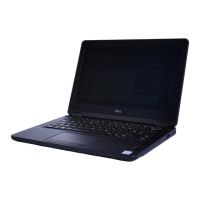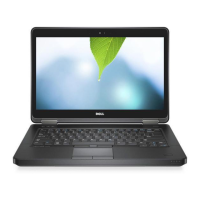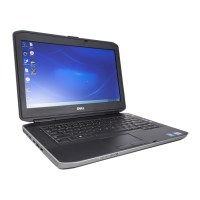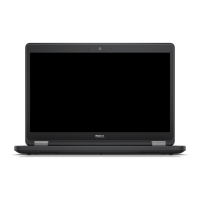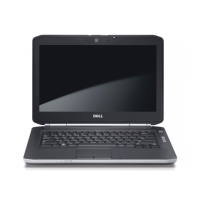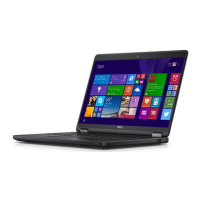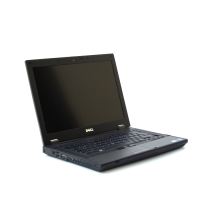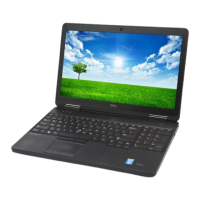Do you have a question about the Dell latitude e5270 and is the answer not in the manual?
Defines important information that helps you make better use of your computer.
Warns of potential damage to hardware or loss of data, and how to avoid it.
Indicates a potential for property damage, personal injury, or death.
Provides general safety guidelines to protect your computer and ensure personal safety.
Lists essential preparatory steps before performing any internal computer maintenance.
Details the procedures for safely shutting down the computer for maintenance.
Outlines the final steps required after completing internal computer work.
Lists the necessary tools required for component removal and installation procedures.
Step-by-step instructions for inserting a Subscriber Identification Module (SIM) card.
Instructions for safely removing the computer's bottom access panel.
Procedure for disconnecting and removing the computer's internal battery.
Steps to detach and remove the complete hard drive unit from the system.
Instructions for disconnecting and removing RAM modules from the motherboard.
Procedure for removing the Wireless Local Area Network card.
Steps to detach and remove the computer's keyboard assembly.
Detailed guide for disconnecting and removing the main computer motherboard.
Configures the order in which the computer attempts to find an operating system.
Lists options for configuring integrated hardware components like NIC and ports.
Manages system passwords, TPM, and other security-related settings.
Controls power-related settings, battery health, and wake-up features.
Details the procedure for setting new system and setup passwords.
Explains how to delete or modify existing system and setup passwords.
Lists general hardware specifications of the computer, including chipset and buses.
Details the CPU type, series, and L3 cache information.
Provides details on RAM connector, capacity, type, and speed.
Lists available physical ports and connectors on the computer.
Details screen size, resolution, brightness, and refresh rate.
Provides battery type, capacity, dimensions, and operating conditions.
Performs a complete hardware check of the computer without requiring extra equipment.
Explains the meaning of various device status LEDs for diagnostics.
Details the battery status indicator light patterns and their meanings.
Defines important information that helps you make better use of your computer.
Warns of potential damage to hardware or loss of data, and how to avoid it.
Indicates a potential for property damage, personal injury, or death.
Provides general safety guidelines to protect your computer and ensure personal safety.
Lists essential preparatory steps before performing any internal computer maintenance.
Details the procedures for safely shutting down the computer for maintenance.
Outlines the final steps required after completing internal computer work.
Lists the necessary tools required for component removal and installation procedures.
Step-by-step instructions for inserting a Subscriber Identification Module (SIM) card.
Instructions for safely removing the computer's bottom access panel.
Procedure for disconnecting and removing the computer's internal battery.
Steps to detach and remove the complete hard drive unit from the system.
Instructions for disconnecting and removing RAM modules from the motherboard.
Procedure for removing the Wireless Local Area Network card.
Steps to detach and remove the computer's keyboard assembly.
Detailed guide for disconnecting and removing the main computer motherboard.
Configures the order in which the computer attempts to find an operating system.
Lists options for configuring integrated hardware components like NIC and ports.
Manages system passwords, TPM, and other security-related settings.
Controls power-related settings, battery health, and wake-up features.
Details the procedure for setting new system and setup passwords.
Explains how to delete or modify existing system and setup passwords.
Lists general hardware specifications of the computer, including chipset and buses.
Details the CPU type, series, and L3 cache information.
Provides details on RAM connector, capacity, type, and speed.
Lists available physical ports and connectors on the computer.
Details screen size, resolution, brightness, and refresh rate.
Provides battery type, capacity, dimensions, and operating conditions.
Performs a complete hardware check of the computer without requiring extra equipment.
Explains the meaning of various device status LEDs for diagnostics.
Details the battery status indicator light patterns and their meanings.
| Form factor | Clamshell |
|---|---|
| Product type | Laptop |
| Product color | Black |
| Housing material | Carbon fiber |
| Market positioning | Business |
| Memory slots | 2x SO-DIMM |
| Internal memory | 4 GB |
| Memory clock speed | 2133 MHz |
| Memory form factor | SO-DIMM |
| Internal memory type | DDR4-SDRAM |
| Maximum internal memory | 16 GB |
| Memory layout (slots x size) | 1 x 4 GB |
| HDD size | 2.5 \ |
| HDD speed | 7200 RPM |
| HDD interface | SATA III |
| Storage media | HDD |
| Optical drive type | No |
| Card reader integrated | Yes |
| Total storage capacity | 500 GB |
| Compatible memory cards | SD |
| Number of HDDs installed | 1 |
| Intel segment tagging | Enterprise |
| Pixel pitch | 0.202 x 0.202 mm |
| Display surface | Matt |
| Display diagonal | 12.5 \ |
| Display brightness | 200 cd/m² |
| Display resolution | 1366 x 768 pixels |
| Native aspect ratio | 16:9 |
| On-board graphics card ID | 1916 |
| Discrete graphics card model | Not available |
| On-board graphics card model | Intel® HD Graphics 520 |
| Maximum on-board graphics card memory | 1.74 GB |
| On-board graphics card OpenGL version | 4.4 |
| On-board graphics card base frequency | 300 MHz |
| On-board graphics card DirectX version | 12.0 |
| On-board graphics card dynamic frequency (max) | 1000 MHz |
| Audio chip | Realtek ALC3235 |
| Speaker power | 2 W |
| Speakers manufacturer | Waves |
| Number of built-in speakers | 2 |
| Wi-Fi standards | - |
| Ethernet LAN data rates | 10, 100, 1000 Mbit/s |
| Charging port type | DC-in jack |
| USB 2.0 ports quantity | 0 |
| USB 3.2 Gen 1 (3.1 Gen 1) Type-A ports quantity | 3 |
| Pointing device | Touchpad |
| Recovery operating system | Windows 10 Pro |
| Operating system installed | Windows 7 Professional |
| Operating system architecture | 64-bit |
| AC adapter frequency | 50 - 60 Hz |
| AC adapter input voltage | 100 - 240 V |
| Operating altitude | 0 - 3000 m |
| Non-operating altitude | 0 - 10668 m |
| Storage temperature (T-T) | -40 - 65 °C |
| Operating temperature (T-T) | 0 - 35 °C |
| Storage relative humidity (H-H) | 5 - 95 % |
| Operating relative humidity (H-H) | 10 - 90 % |
| Sustainability certificates | EPEAT Gold, ENERGY STAR |
| Bus type | QPI |
| Stepping | D1 |
| Tjunction | 100 °C |
| Processor cache | 3 MB |
| Processor model | i5-6200U |
| System bus rate | 4 GT/s |
| Processor family | Intel® Core™ i5 |
| Processor series | Intel Core i5-6200 series |
| Processor socket | LGA 1356 (Socket B2) |
| Processor threads | 4 |
| Processor codename | Skylake |
| Configurable TDP-up | 25 W |
| Processor frequency | 2.3 GHz |
| Processor cache type | Smart Cache |
| Configurable TDP-down | 7.5 W |
| Processor lithography | 14 nm |
| Processor manufacturer | Intel |
| PCI Express slots version | 3.0 |
| Processor boost frequency | 2.8 GHz |
| PCI Express configurations | 1x4, 4x1 |
| Thermal Design Power (TDP) | 15 W |
| Configurable TDP-up frequency | 2.4 GHz |
| Configurable TDP-down frequency | 0.8 GHz |
| Maximum number of PCI Express lanes | 12 |
| Processor code | SR2EY |
| Processor ARK ID | 88193 |
| Processor package size | 42 X 24 mm |
| Supported instruction sets | SSE4.1, SSE4.2, AVX 2.0 |
| Intel Secure Key Technology version | 1.00 |
| Intel Stable Image Platform Program (SIPP) version | 0.00 |
| Depth | 214.5 mm |
|---|---|
| Width | 310.5 mm |
| Height | 22.65 mm |
| Weight | 1490 g |
